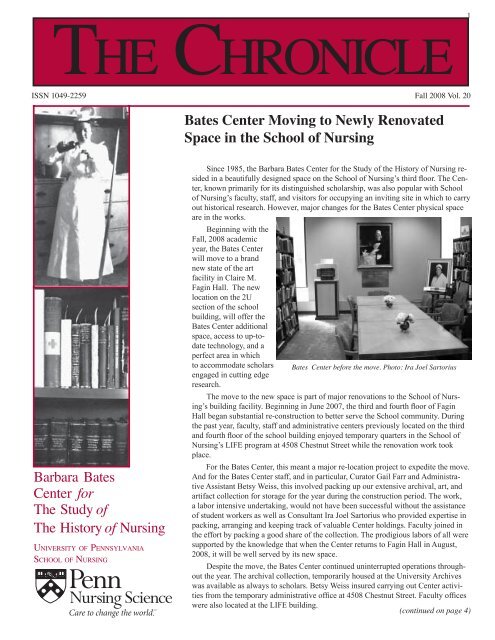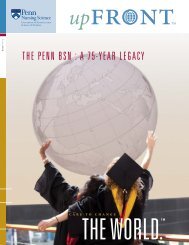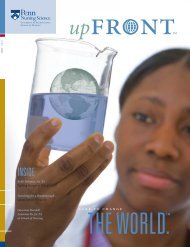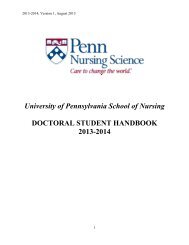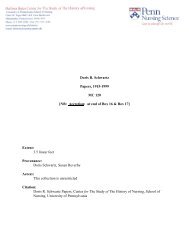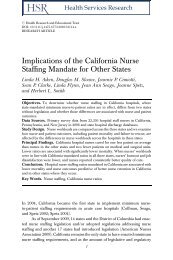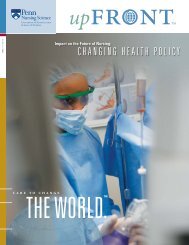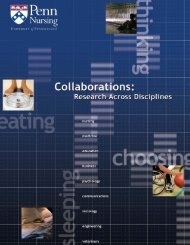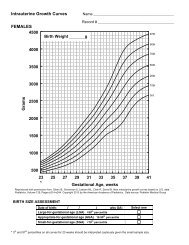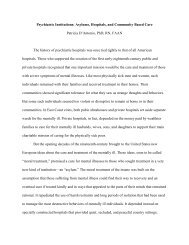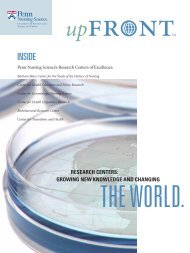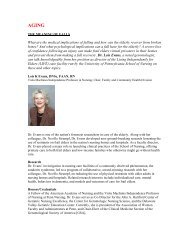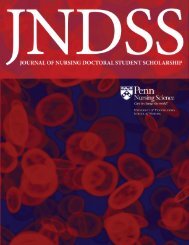Fall - University of Pennsylvania School of Nursing
Fall - University of Pennsylvania School of Nursing
Fall - University of Pennsylvania School of Nursing
You also want an ePaper? Increase the reach of your titles
YUMPU automatically turns print PDFs into web optimized ePapers that Google loves.
1<br />
ISSN 1049-2259<br />
<strong>Fall</strong> 2008 Vol. 20<br />
Bates Center Moving to Newly Renovated<br />
Space in the <strong>School</strong> <strong>of</strong> <strong>Nursing</strong><br />
Since 1985, the Barbara Bates Center for the Study <strong>of</strong> the History <strong>of</strong> <strong>Nursing</strong> resided<br />
in a beautifully designed space on the <strong>School</strong> <strong>of</strong> <strong>Nursing</strong>’s third floor. The Center,<br />
known primarily for its distinguished scholarship, was also popular with <strong>School</strong><br />
<strong>of</strong> <strong>Nursing</strong>’s faculty, staff, and visitors for occupying an inviting site in which to carry<br />
out historical research. However, major changes for the Bates Center physical space<br />
are in the works.<br />
Beginning with the<br />
<strong>Fall</strong>, 2008 academic<br />
year, the Bates Center<br />
will move to a brand<br />
new state <strong>of</strong> the art<br />
facility in Claire M.<br />
Fagin Hall. The new<br />
location on the 2U<br />
section <strong>of</strong> the school<br />
building, will <strong>of</strong>fer the<br />
Bates Center additional<br />
space, access to up-todate<br />
technology, and a<br />
perfect area in which<br />
to accommodate scholars Bates Center before the move. Photo: Ira Joel Sartorius<br />
engaged in cutting edge<br />
research.<br />
The move to the new space is part <strong>of</strong> major renovations to the <strong>School</strong> <strong>of</strong> <strong>Nursing</strong>’s<br />
building facility. Beginning in June 2007, the third and fourth floor <strong>of</strong> Fagin<br />
Hall began substantial re-construction to better serve the <strong>School</strong> community. During<br />
the past year, faculty, staff and administrative centers previously located on the third<br />
and fourth floor <strong>of</strong> the school building enjoyed temporary quarters in the <strong>School</strong> <strong>of</strong><br />
<strong>Nursing</strong>’s LIFE program at 4508 Chestnut Street while the renovation work took<br />
place.<br />
For the Bates Center, this meant a major re-location project to expedite the move.<br />
And for the Bates Center staff, and in particular, Curator Gail Farr and Administrative<br />
Assistant Betsy Weiss, this involved packing up our extensive archival, art, and<br />
artifact collection for storage for the year during the construction period. The work,<br />
a labor intensive undertaking, would not have been successful without the assistance<br />
<strong>of</strong> student workers as well as Consultant Ira Joel Sartorius who provided expertise in<br />
packing, arranging and keeping track <strong>of</strong> valuable Center holdings. Faculty joined in<br />
the effort by packing a good share <strong>of</strong> the collection. The prodigious labors <strong>of</strong> all were<br />
supported by the knowledge that when the Center returns to Fagin Hall in August,<br />
2008, it will be well served by its new space.<br />
Despite the move, the Bates Center continued uninterrupted operations throughout<br />
the year. The archival collection, temporarily housed at the <strong>University</strong> Archives<br />
was available as always to scholars. Betsy Weiss insured carrying out Center activities<br />
from the temporary administrative <strong>of</strong>fice at 4508 Chestnut Street. Faculty <strong>of</strong>fices<br />
were also located at the LIFE building.<br />
(continued on page 4)
2<br />
Barbara Bates Center<br />
for The Study <strong>of</strong> The<br />
History <strong>of</strong> <strong>Nursing</strong><br />
News from the Center<br />
The Barbara Bates Center for The Study <strong>of</strong><br />
The History <strong>of</strong> <strong>Nursing</strong> was established in<br />
1985 to encourage and facilitate historical<br />
scholarship on health care history and nursing<br />
in the United States. The Bates Center<br />
maintains resources for research; to improve<br />
the quality and scope <strong>of</strong> historical scholarship<br />
on nursing; and to disseminate new<br />
knowledge on nursing history through education,<br />
conferences, publications, and interdisciplinary<br />
collaboration.<br />
Current projects at the Center range from<br />
studies <strong>of</strong> international nursing, home-based<br />
nursing, and research on care <strong>of</strong> the critically<br />
ill to the twentieth-century relationship<br />
between nursing and American philanthropy.<br />
We also continue to collect, process, and<br />
catalogue an outstanding collection <strong>of</strong> primary<br />
historical materials.<br />
Center Hours are Monday through Friday,<br />
9:00 am. to 5:00 pm. Scholars planning to<br />
conduct research at the Center should contact<br />
the Center’s curator at 215-898-4502. Our<br />
curator will respond with a description <strong>of</strong> the<br />
scope and content <strong>of</strong> relevant materials in the<br />
various collections.<br />
Center Advisory Board<br />
Ellen D. Baer, Chair<br />
M. Louise Fitzpatrick, Vice Chair<br />
Lillian Sholtis Brunner<br />
Ruth Schwartz Cowan<br />
Hannah Henderson<br />
Jeanne Kiefner<br />
Ann P. Knight<br />
Nadine Landis<br />
Mark Frazier Lloyd<br />
Charles E. Rosenberg<br />
Rosalyn Watts<br />
Center Staff<br />
Julie Fairman, PhD, RN, FAAN<br />
Director<br />
Patricia D’Antonio, PhD, RN, FAAN<br />
Barbra Mann Wall, PhD, RN<br />
Associate Directors<br />
Karen Buhler-Wilkerson, PhD, RN, FAAN<br />
Joan E. Lynaugh, PhD, RN, FAAN<br />
Directors Emerita<br />
Julie Solchaski, PhD, RN, FAAN<br />
Fellow<br />
Jean C. Whelan, PhD, RN<br />
Special Projects Director<br />
Gail E. Farr, MA, CA<br />
Curator<br />
Betsy Weiss, Administrative Assistant<br />
Rita Beatty, Volunteer<br />
From left to right: Joan Lynaugh, Julie Fairman and Ellen Baer on the occasion <strong>of</strong><br />
Karen Buhler Wilkerson’s retirement party. Photo: Ira Joel Sartorius<br />
Since the publication <strong>of</strong> the last<br />
Chronicle, the Bates <strong>Nursing</strong> History<br />
Center has seen major changes, accomplishments,<br />
and achievements.<br />
In July, 2006, Dr. Karen Buhler-<br />
Wilkerson began a well deserved retirement<br />
from the Faculty <strong>of</strong> the <strong>School</strong><br />
<strong>of</strong> <strong>Nursing</strong> and the Directorship <strong>of</strong><br />
the Bates <strong>Nursing</strong> History Center. Dr.<br />
Buhler-Wilkerson served as the second<br />
Director <strong>of</strong> the Bates Center succeeding<br />
Dr. Joan Lynaugh in 1995. Dr. Buhler-<br />
Wilkerson is engaging in a very active<br />
retirement period as she continues her<br />
research activities here at the Bates <strong>Nursing</strong><br />
History Center and serves as Center<br />
Director Emerita.<br />
Dr. Julie Fairman, well known to all<br />
at the Bates <strong>Nursing</strong> History Center, was<br />
named Center Director in 2006 following<br />
Dr. Buhler-Wilkerson’s retirement.<br />
Dr. Fairman, an Associate Pr<strong>of</strong>essor <strong>of</strong><br />
<strong>Nursing</strong>, has been connected with the<br />
Bates <strong>Nursing</strong> History Center since 1985<br />
when she began doctoral studies. She has<br />
held numerous teaching positions at the<br />
<strong>School</strong> since 1981 and was appointed<br />
to the faculty in 1995. Dr. Fairman is<br />
well recognized in the nursing history<br />
community for her research on the emergence<br />
<strong>of</strong> hospital critical care units and<br />
the nurse practitioner movement.<br />
In the <strong>Fall</strong>, 2006, Dean Afaf Meleis<br />
announced the appointment <strong>of</strong> two faculty<br />
members to newly created positions<br />
for nursing history naming Drs. Patricia<br />
D’Antonio and Barbra Mann Wall to Associate<br />
Pr<strong>of</strong>essorships. Dr. D’Antonio<br />
was and still is an Associate Director <strong>of</strong><br />
the Bates <strong>Nursing</strong> History Center and<br />
had been an Adjunct Associate Pr<strong>of</strong>essor<br />
<strong>of</strong> <strong>Nursing</strong> since 1995. In her research,<br />
Dr. D’Antonio positions nurses as absolutely<br />
central to the larger interdisciplinary<br />
histories <strong>of</strong> institutions, clinical<br />
practice, health care policy, and women’s<br />
care work.<br />
Dr. Barbra Mann Wall comes to the<br />
Center from Purdue <strong>University</strong> where<br />
she was Associate Pr<strong>of</strong>essor and Director<br />
<strong>of</strong> the Center for <strong>Nursing</strong> History, Ethics,<br />
and Innovation. She is widely known for<br />
her studies on women and health care institutions.<br />
Dr. Wall is also a Bates <strong>Nursing</strong><br />
History Center Associate Director.<br />
Dr. Julie Solchaski joined the Bates<br />
<strong>Nursing</strong> History Center as a Fellow in<br />
the <strong>Fall</strong>, 2007. Her research centers on<br />
the relationship between the structure<br />
and the quality <strong>of</strong> care and patient outcomes,<br />
and on domestic and international<br />
trends in the healthcare workforce and<br />
their implications for public policy.<br />
Dr. Ellen Baer, Pr<strong>of</strong>essor Emerita <strong>of</strong><br />
<strong>Nursing</strong>, <strong>University</strong> <strong>of</strong> <strong>Pennsylvania</strong> and<br />
Visiting Pr<strong>of</strong>essor <strong>of</strong> <strong>Nursing</strong>, Florida<br />
Atlantic <strong>University</strong> assumed the Chairpersonship<br />
<strong>of</strong> the Bates <strong>Nursing</strong> History<br />
Center Advisory Board in September,<br />
2006.
Dr. Rosalyn Watts, Pr<strong>of</strong>essor<br />
Emerita <strong>of</strong> <strong>Nursing</strong> at the <strong>University</strong> <strong>of</strong><br />
<strong>Pennsylvania</strong> <strong>School</strong> <strong>of</strong> <strong>Nursing</strong> joined<br />
the Advisory Board in 2006.<br />
Grants<br />
Dr. Julie Fairman received a prestigious<br />
Investigator Award Grant from<br />
the Robert Wood Johnson Foundation<br />
for a three year study entitled Practice<br />
Politics: History <strong>of</strong> <strong>Nursing</strong> 1975 to<br />
the Present. Dr. Fairman uses the nurse<br />
practitioner movement to explore the<br />
public and private forces propelling the<br />
specialization <strong>of</strong> nursing in the U.S.<br />
Her project takes a comprehensive<br />
look at nurse practitioners and their<br />
role in health care delivery – their<br />
aspirations for pr<strong>of</strong>essional growth<br />
and autonomy, their education and pr<strong>of</strong>essional<br />
certification, state regulation,<br />
reimbursement for their services, federal<br />
and philanthropic funding for nursing<br />
education, and the influences <strong>of</strong> nurse<br />
specialty organizations and the American<br />
Nurses Association. Her work will<br />
reveal how the nursing pr<strong>of</strong>ession has<br />
helped shape the American health care<br />
system as it responded to the need and<br />
demand for health care services while<br />
also promoting its own political and economic<br />
self-interests.<br />
Center Associate Directors Patricia D’Antonio (left)<br />
and Barbra Mann Wall Photo: Ira Joel Sartorius<br />
Dr. Patricia D’Antonio recently<br />
completed a three year National Library<br />
<strong>of</strong> Medicine grant for a study entitled<br />
<strong>Nursing</strong> in the US: A History <strong>of</strong> People<br />
and Places’ which examined the work<br />
<strong>of</strong> nurses in hospitals and as members <strong>of</strong><br />
geographically, ethnically, racially diverse<br />
families and communities.<br />
In 2008, Dr. D’Antonio received a<br />
National Endowment for the Humanities<br />
Faculty Fellowship to complete her upcoming<br />
work, American <strong>Nursing</strong>: Neighborhood<br />
Work and National Mission.<br />
This support will allow her to complete a<br />
book that will be the first major re-thinking<br />
<strong>of</strong> nursing’s history since the seminal<br />
works <strong>of</strong> the 1980s. Dr. D’Antonio’s research<br />
situates nurses and nursing within<br />
families and communities as well as<br />
within hospitals and health care agencies.<br />
This award recognizes the importance <strong>of</strong><br />
Dr. D’Antonio’s prior historiographical<br />
and data based research. It allows her to<br />
continue to explore how nursing helped<br />
women and some men, including those<br />
<strong>of</strong> color and different ethnic and religious<br />
backgrounds, construct consequential<br />
personal as well as pr<strong>of</strong>essional lives.<br />
In 2007, Dr. Barbra Mann Wall received<br />
a <strong>University</strong> <strong>of</strong> <strong>Pennsylvania</strong> Research<br />
Foundation grant for her study, A<br />
Comparative History <strong>of</strong> Catholic Hospitals<br />
in the Twentieth Century. This award<br />
allowed her to lay the methodological<br />
groundwork that extends the analysis <strong>of</strong><br />
her first book, Unlikely Entrepreneurs:<br />
Catholic Sisters and the Hospital Marketplace,<br />
1865-1925, into the 20 th century.<br />
Dr. Wall’s long-term goal is to complete<br />
a full-length book manuscript that<br />
will examine the problem <strong>of</strong> how Catholic<br />
hospitals were and are simultaneously<br />
religious and secular institutions.<br />
Dr. Wall has also received the Trustees’<br />
Council <strong>of</strong> Penn Women Faculty<br />
Summer Research Fellowship in support<br />
<strong>of</strong> her study, Clash and Compromise:<br />
Women, Gender, and Reproductive Services<br />
in Catholic Hospitals, 1960-2000.<br />
This research focuses on the history <strong>of</strong><br />
hospitals from 1925 to 2000 through the<br />
lens <strong>of</strong> religious nursing congregations,<br />
with special reference to how Catholic<br />
sisters balanced their mission to serve<br />
the poor with the need to comply with<br />
church teachings on women’s reproductive<br />
issues.<br />
Dr. Wall received a 2008 Fichter<br />
Research Award from the Association for<br />
the Sociology <strong>of</strong> Religion and an H-15<br />
Grant Historical Research Award from<br />
the American Association for the History<br />
<strong>of</strong> <strong>Nursing</strong> for her proposal, Clash and<br />
Compromise: Catholic Hospitals, Secularization,<br />
and the State in 20 th Century<br />
America. This study continues her work<br />
on Catholic hospitals.<br />
Dr. Julie Solchaski was awarded<br />
a grant to carry out the 2008 National<br />
Sample Survey <strong>of</strong> Registered Nurses (NS-<br />
SRN). The NSSRN is completed every<br />
four years and is the most comprehensive<br />
enumeration <strong>of</strong> nurses in the United<br />
States. Dr. Sochalski is also a Co-Investigator<br />
on a five year National Institute<br />
<strong>of</strong> Health grant entitled Health Related<br />
Quality <strong>of</strong> Life: Elders in Long-Term<br />
Care<br />
Dr. Jean Whelan continues work on<br />
two National Library <strong>of</strong> Medicine grants.<br />
The first grant entitled Never Enough:<br />
Nurse Supply and Demand, 1900-1965<br />
examines how pr<strong>of</strong>essional nurses organized<br />
their work and analyzes the<br />
relationship between pr<strong>of</strong>essional nurses’<br />
working conditions and supply and demand<br />
problems related to the delivery<br />
<strong>of</strong> nursing care between 1900-1965. Dr.<br />
Whelan is also a Co-Investigator on a<br />
second National Library <strong>of</strong> Medicine<br />
grant, <strong>Nursing</strong>, History and Healthcare:<br />
A Website, which will result in the creation<br />
<strong>of</strong> a website that will document,<br />
analyze and place in historical context<br />
the most compelling and controversial<br />
political and social issues influencing the<br />
provision <strong>of</strong> nursing care and connect<br />
them to relevant policy implications<br />
Dr. Karen Buhler-Wilkerson is Co-<br />
Investigator on the National Library <strong>of</strong><br />
Medicine grant <strong>Nursing</strong>, History and<br />
Healthcare: A Website (see above).<br />
Doctoral student Jonathan Gilbride<br />
is completing a T-32 Pre-doctoral fellowship<br />
through the Center for Health Policy<br />
and Research Outcomes. The title <strong>of</strong> Mr.<br />
Gilbride’s doctoral study is Nurses’ Involvement<br />
in Health Policy: The Clinton<br />
Health Plan.<br />
Doctoral student J. Margo Brooks<br />
Carthon received a Ruth L. Kirschstein<br />
National Research Service Pre-Doctoral<br />
Fellowship Award from the Agency for<br />
Health Care Research and Quality for her<br />
proposal. We Will Not Be Moved:<br />
The Black Church Health Movement.<br />
To support her studies, recent<br />
graduate, Dr. Jennifer Hobbs received a<br />
Department <strong>of</strong> Veterans Affairs Pre-Doc-<br />
3<br />
(continued on page 4)
4<br />
Stephanie A. Stachniewicz, Founding Member<br />
by Joan Lynaugh<br />
Long before the<br />
Bates Center was<br />
conceived <strong>of</strong> in 1985<br />
and actually opened<br />
in 1989, Stephanie<br />
Stachniewicz was its<br />
innovative, vigorous,<br />
thoughtful and committed<br />
advocate. With<br />
history initiatives just<br />
in the talking stage<br />
during the early 1980s,<br />
Lillian Shotis Brunner<br />
decided to introduce<br />
Joan Lynaugh to<br />
Stephanie over lunch.<br />
And, from there, all<br />
sorts <strong>of</strong> important happenings<br />
emanated. As<br />
a long time influential<br />
leader <strong>of</strong> the Philadelphia<br />
General Hospital<br />
Alumnae Association,<br />
Stephanie was able to<br />
bring the support <strong>of</strong><br />
these important nurses<br />
Stephanie Stachniewicz and Mayor <strong>of</strong> Philadelphia James Tate.<br />
Photo: Philadelphia General Hospital <strong>School</strong> <strong>of</strong> <strong>Nursing</strong> Collection<br />
BBCSHN<br />
to the Center. Their decision to place their collections with the Center had a major impact<br />
on other individuals and groups. Stephanie became the Secretary <strong>of</strong> the Advisory<br />
Board <strong>of</strong> the Center when the Board was organized under Lillian Brunner’s guidance<br />
in 1985. She served on that Board for the next seventeen years. She gave sound advice,<br />
she raised money to support the work <strong>of</strong> history, she encouraged us when we wondered<br />
if it all would work, and she made sure that everything about the Center was the best.<br />
One <strong>of</strong> Stephanie’s great ideas was the Alice Fisher Summer Fellowship underwritten<br />
by a major gift from the Philadelphia General Hospital <strong>School</strong> <strong>of</strong> <strong>Nursing</strong><br />
(PGH) Alumnae which has supported 14 scholars to date. Another was the revival <strong>of</strong><br />
the annual procession to the graves <strong>of</strong> Alice Fisher and Lillian Clayton (both influlential<br />
PGH nurse educators) which occured in May for many years. Everyone had fun,<br />
ate well in the Hamilton Mansion and shared prideful thoughts about our predecessors.<br />
After graduating from the PGH <strong>School</strong> <strong>of</strong> <strong>Nursing</strong> in 1947 (as a member <strong>of</strong><br />
the Cadet Nurse Corps) she practiced in the Pulmonary Department and then Emergency<br />
Service; later, she taught and practiced in the Out Patient Department. As part<br />
<strong>of</strong> her faculty role in the PGH <strong>School</strong> <strong>of</strong> <strong>Nursing</strong> she taught History <strong>of</strong> <strong>Nursing</strong>. Meanwhile,<br />
Stephanie earned a BSNE from Penn in 1956 and her MSN in 1967. Her intellectual<br />
strength and decision making ability made it seem inevitable that she would be<br />
selected for the huge job <strong>of</strong> Director <strong>of</strong> the <strong>School</strong> <strong>of</strong> <strong>Nursing</strong> and <strong>Nursing</strong> Service at<br />
PGH in 1972. During the conflicted and difficult years leading to the closing <strong>of</strong> PGH<br />
and its <strong>School</strong> <strong>of</strong> <strong>Nursing</strong> in 1977, Stephanie Stachniewicz exhibited leadership which<br />
is recalled with respect and fondness by all those involved.<br />
In 1978, she and Jean Axelod published The Double Frill: The History <strong>of</strong> the<br />
Philadelphia General Hospital <strong>School</strong> <strong>of</strong> <strong>Nursing</strong> . This is an outstanding work which<br />
is used to this day as an exact and accurate history <strong>of</strong> nursing in Philadelphia.<br />
(Rennovations, continued)<br />
Although all associated with the<br />
Center were very comfortable in the<br />
old space, the new space will be more<br />
user friendly, expansive, and will allow<br />
faculty, staff, and researchers to interact<br />
in contiguous spaces. Upon entry to the<br />
new Center, Betsy Weiss, who will<br />
occupy a desk in a central reception<br />
area, will as always, immediately greet<br />
visitors. The Alumnae Association <strong>of</strong><br />
the Hospital <strong>of</strong> the <strong>University</strong> <strong>of</strong> <strong>Pennsylvania</strong><br />
will have a prominent <strong>of</strong>fice<br />
and display space. Faculty <strong>of</strong>fices are<br />
located within the Center. There are designated<br />
spaces for doctoral students and<br />
a post-doctoral fellow. A conference<br />
room with state <strong>of</strong> the art technology will<br />
support our seminar series and meeting<br />
needs.<br />
The new reading room will provide<br />
much needed research space for visiting<br />
scholars and help us apply archival<br />
access policies similar to those found at<br />
other established repositories. Researchers<br />
will have lockers to store personal<br />
belongings, and there is a public seating<br />
section behind our reception area to<br />
accommodate them when Betsy Weiss<br />
must leave her desk to retrieve needed<br />
collection items. The reading room is<br />
glass-enclosed, creating an atmosphere<br />
<strong>of</strong> openness and light, and at the same<br />
time, providing a quiet space for concentrating<br />
on and accomplishing critical<br />
work.<br />
(News from the Center, continued)<br />
toral Nurse Fellowship; the Bates Center<br />
Alice Fisher Fellowship; NANDA~I<br />
Foundation Grant; the American Association<br />
for the History <strong>of</strong> <strong>Nursing</strong> Doctoral<br />
Student Research Award; and the<br />
Gamma Gamma and Xi Chapters <strong>of</strong> Sigma<br />
Theta Tau International Grant. She<br />
completed her dissertation in June and<br />
will begin a post-doctoral Department <strong>of</strong><br />
Veteran Affairs Fellowship this fall.<br />
Center Publications<br />
Karen Buhler Wilkerson, “Care <strong>of</strong><br />
the Chronically Ill at Home: An Unresolved<br />
Dilemma in Health Policy for<br />
the US,” Milbank Quarterly, 2008, (4),<br />
611-639.
Patricia D’Antonio, “Nurses – and<br />
Wives and Mothers: Women and the<br />
Latter Day Saints Training <strong>School</strong>’s<br />
Class <strong>of</strong> 1919,” Journal <strong>of</strong> Women’s<br />
History, 2007, 19 (3): 112-136.<br />
Julie Fairman and Patricia<br />
D’Antonio, “Reimagining <strong>Nursing</strong>’s<br />
Place in the History <strong>of</strong> Clinical Practice,”<br />
Journal <strong>of</strong> the History <strong>of</strong> Medicine<br />
and Allied Sciences, Advance Access<br />
published on March 28, 2008.<br />
Julie Fairman, “Context and Contingency:<br />
The Post World War II History<br />
<strong>of</strong> <strong>Nursing</strong> Scholarship.” Journal<br />
<strong>of</strong> <strong>Nursing</strong> Scholarship, 2008 40 (1):<br />
4-11.<br />
Barbra Mann Wall, “Twenty-Five<br />
Years <strong>of</strong> Historical Scholarship.” <strong>Pennsylvania</strong><br />
Nurse, 2008 63 (2): 10-12.<br />
Barbra Mann Wall, “Looking<br />
Back: Celebrating <strong>Nursing</strong> History,”<br />
American Journal <strong>of</strong> <strong>Nursing</strong>, 2008,<br />
108 (6): 26-29.<br />
Barbra Mann Wall, Nancy Edwards,<br />
and Marjorie Porter, “Textual<br />
Analysis <strong>of</strong> Retired Nurses’ Oral Histories,”<br />
<strong>Nursing</strong> Inquiry, 2007, 14 (4):<br />
279-288.<br />
Patricia D’Antonio, Ellen Baer,<br />
Sylvia Rinker & Joan Lynaugh (2007).<br />
Nurses’ Work: Issues Across Time and<br />
Place. New York: Springer Publishing.<br />
Several faculty also contributed<br />
chapters to a newly released book on the<br />
research methodology <strong>of</strong> nursing history<br />
See Sandra Lewenson and Eleanor Herrmann<br />
(Eds.) (2008), Capturing <strong>Nursing</strong><br />
History. New York: Springer Publishing.<br />
A New Book<br />
Making Room in the Clinic: Nurse<br />
Practitioners and the Evolution <strong>of</strong><br />
Modern Health Care by Julie Fairman<br />
(Rutgers <strong>University</strong> Press) is a welcome<br />
addition to anyone’s bookshelf. As noted<br />
on the book jacket, “In Making Room in<br />
the Clinic, Julie Fairman examines the<br />
context in which the nurse practitioner<br />
movement emerged, how large political<br />
and social movements influenced it,<br />
and how it contributed to the changing<br />
definition <strong>of</strong> medical care. Drawing on<br />
a wealth <strong>of</strong> primary source material,<br />
including interviews with key figures in<br />
the movement, Fairman describes how<br />
this evolution helped create an influential<br />
foundation for health policies that<br />
Julie Fairman’s book, Making Room in the Clinic:<br />
Nurse Practitioners and the Evolution <strong>of</strong> Modern<br />
Health Care<br />
emerged at the end <strong>of</strong> the twentieth<br />
century, including health maintenance<br />
organizations, a renewed interest in<br />
health awareness and disease prevention,<br />
and consumer-based services.”<br />
Dr. Fairman’s book is an insightful<br />
look into the history <strong>of</strong> nurse practitioners<br />
which advances our knowledge <strong>of</strong><br />
this critical movement and provides a<br />
scholarly lens through which to view<br />
the present status <strong>of</strong> health care and<br />
health care policy in the United States.<br />
Making Room in the Clinic is a highly<br />
recommended must read!<br />
International Happenings<br />
Faculty and students <strong>of</strong> the Bates<br />
Center have been active on the international<br />
scene delivering papers at<br />
conferences and universities including<br />
Germany, Canada and Denmark. Drs.<br />
Patricia D’Antonio and Julie Fairman<br />
presented their research at the 2nd International<br />
History <strong>of</strong> <strong>Nursing</strong> Conference<br />
sponsored by the Institut für Geschichte<br />
der Medizin der Robert Bosch<br />
Stiftung in March 2008 in Stuttgart,<br />
Germany.<br />
5<br />
Dr. Barbra Mann Wall has been busy<br />
initiating and coordinating a movement<br />
to have nursing history included as a<br />
section <strong>of</strong> the International Council <strong>of</strong><br />
Nurses (ICN). In January 2008, directors<br />
<strong>of</strong> nursing history centers in the United<br />
States, Canada, Australia, Germany,<br />
England, Ireland, and Denmark wrote to<br />
the Executive Director and the President<br />
<strong>of</strong> the ICN, requesting that nursing history<br />
be included as a section in the 2009<br />
ICN conference in Durban, South Africa<br />
to which Dr. Judith Oulton, Executive<br />
Director <strong>of</strong> the ICN, concurred. At the<br />
Canadian <strong>Nursing</strong> History Association<br />
meeting in Toronto in June 2008, nursing<br />
historians made tentative plans for<br />
the Durban meeting deciding to form a<br />
panel to discuss steps needed to become<br />
an Affiliate <strong>of</strong> the ICN.Through the ICN,<br />
historians from across the globe can participate<br />
in the international exchange <strong>of</strong><br />
ideas, experience, and expertise for the<br />
nursing pr<strong>of</strong>ession. This joint project will<br />
allow significant collaborations that can<br />
bring important historical, sociological,<br />
and cultural contexts to events that have<br />
shaped the nursing pr<strong>of</strong>ession.<br />
Dr. Wall also gave one <strong>of</strong> three<br />
keynote addresses at the First Danish<br />
<strong>Nursing</strong> History Conference in a talk<br />
titled, The History <strong>of</strong> <strong>Nursing</strong> History in<br />
Kolding, Denmark in September, 2007.<br />
She presented Public Representations <strong>of</strong><br />
Religion: The American Catholic Hospital<br />
at the Religion in Education, Culture<br />
and Society Conference in Bremen, Germany,<br />
sponsored by the European Association<br />
for the Study <strong>of</strong> Religion, Sept.<br />
25, 2007.<br />
At the American Association <strong>of</strong> the<br />
History <strong>of</strong> Medicine Annual Conference<br />
in April, 2008, three <strong>of</strong> our faculty,<br />
Drs. Julie Fairman, Patricia D’Antonio<br />
and Barbara Wall organized, hosted and<br />
presented at the Sigerist Circle Panel<br />
entitled <strong>Nursing</strong> and Activism. Joining<br />
them on the panel were fellow historians<br />
Drs. Meryn Stuart, Cynthia Connolly and<br />
Arlene Keeling.<br />
Presenting at the Canadian Association<br />
for the History <strong>of</strong> <strong>Nursing</strong>’s International<br />
<strong>Nursing</strong> History Conference in<br />
Toronto, Canada in June, 2008 were Drs.<br />
Barbra MannWall, Patricia D’Antonio,<br />
Julie Fairman and Jennifer Hobbs and<br />
doctoral student Winifred C. Connerton.<br />
(continued on page 6)
6<br />
Donors to The Barbara Bates Center for The Study <strong>of</strong> The History <strong>of</strong> <strong>Nursing</strong><br />
January 1, 2007 through December 31, 2007<br />
ACNM Inland Desert Chapter<br />
Dr. Linda H. Aiken<br />
Alumnae Association <strong>of</strong> Mercy Douglas<br />
Dr. Lauren S. Arnold<br />
Mrs. Ann C. Baiada<br />
Mr. J Mark Baiada<br />
Mr. Jack D. Barchas<br />
Dr. Nira Bartal<br />
Dr. Elizabeth M. Bear<br />
Miss Rita T. Beatty<br />
Dr. Jeanne Quint Benoliel<br />
Ms. Marilyn Bicking<br />
Dr. Nettie Birnbach<br />
Dr. Eleanor Crowder Bjoring<br />
Mrs. Marion Bryde Bogen<br />
Dr. Geertje Boschma<br />
Dr. Ann Marie Walsh Brennan<br />
Dr. Joan U. Bretschneider<br />
Dr. Barbara Brodie<br />
Mrs. Frances Brouse<br />
Dr. Lillian Sholtis Brunner<br />
Dr. Karen A. Buhler-Wilkerson<br />
Dr. Kathleen G. Burke<br />
Mr. and Mrs. John C. Burnham<br />
Mrs. Barbara Chamberlain<br />
Ms. Pamela Frances Cipriano<br />
Mrs. Beryl Boardman Cleary<br />
Mrs. Linda Clougherty<br />
Dr. Cynthia A. Connolly<br />
Mr. Nicholas Connolly<br />
Ms. Grace K. Coulson<br />
Mr. and Mrs. Malcolm F. Crawford<br />
Ms. Sarah T. Cunningham<br />
Dr. Joseph C. D’Antonio<br />
Dr. Patricia O. D’Antonio<br />
Dr. Katherine L. Dawley<br />
Dr. Lynore D. Desilets<br />
Robert M. Elfont, MD<br />
Dr. Grace P. Erickson<br />
Ms. Jean K. Ferguson<br />
Ms. Janet L. Fickeissen<br />
Dr. M. Louise Fitzpatrick<br />
Dr. Marilyn E. Flood<br />
Mrs. Sylvia Waltz Fuller<br />
Ms. Barbara Gaines<br />
Mr. William C. Garrow<br />
Dr. Carol P. Germain<br />
Miss Erna I. Goulding<br />
Ms. Isabella S. Harrison<br />
Mrs. Patricia A. Heffner<br />
Dr. Carol S. Helmstadter<br />
Dr. Eleanor K. Herrmann<br />
Dr. Christy Hoover<br />
Ms. Lynn Houweling<br />
Aram K. Jerrehian, Jr., Esquire<br />
Mrs. Jacqueline M. Jerrehian<br />
Mrs. Dorothy Goldstein Kapenstein<br />
Dr. Arlene W. Keeling<br />
Mrs. Josephine D. Keiser<br />
Mrs. Alda E. Kerschner<br />
Mr. Robert S. Killebrew, Jr.<br />
Mrs. Pedie Killebrew<br />
Ms. Ann P. Knight<br />
Mr. Berton E. Korman<br />
Mrs. Sallie G. Korman<br />
Dr. Mary Ann Krisman-Scott<br />
Ms. Jan L. Lee<br />
Charles E. Letocha, MD<br />
Mrs. Helene B. Kuritz Levy<br />
Ms. Martha P. Livingston<br />
Mr. Mark F. Lloyd<br />
Mrs. Elizabeth P. Losa<br />
Mrs. Barbara Lund<br />
Dr. Joan E. Lynaugh<br />
Dr. Diane J. Mancino<br />
Mrs. Barbara Barden Mason<br />
Ms. Diana J. Mason<br />
Dr. E. Ann Matter<br />
Ms. Rose Ann McGarrity<br />
Dr. Therese Meehan<br />
Ms. Adrian S. Melissinos<br />
Ms. Kathryn M. Mershon<br />
Ms. Mary Alice Musser<br />
Mr. William H. Nace<br />
Ms. Pauline Reid Oliver<br />
Dr. Ann L. O’Sullivan<br />
Ms. Maral Palanjian<br />
Mrs. Julia Boland Paparella, RN<br />
Mr. John L. Parascandola<br />
Steven J. Peitzman, MD<br />
Mrs. Annette Marie Pettineo<br />
Ms. Adele W. Pike<br />
Ms. Laura M. Randar<br />
Mrs. Joan S. Randolph<br />
Dr. Elizabeth A. Reedy<br />
Dr. Susan Reverby<br />
Ms. Natalie N. Riegler<br />
Dr. Deborah A. Sampson<br />
Ms. Alice Savastio<br />
Mrs. Norma Rohrbaugh Shue<br />
Ms. Grace Sills<br />
Miss Grace A. Slotterback<br />
Dr. Suzanne C. Smeltzer<br />
Ms. Janet E. Smith<br />
Ms. Maude M. Smith<br />
Miss Nancy T. Snyder<br />
Ernest B. Spangler, Jr., MD<br />
Mrs. Jean Martin Spangler<br />
Miss S. A. Stachniewicz<br />
Mrs. Lucy E. Stetter<br />
Dr. Rosemary A. Stevens<br />
Mrs. Norma H. Stewart<br />
Robert J. Stewart, Esq.<br />
Dr. Bayard T. Storey<br />
Mrs. Frances E. Storey<br />
Mr. and Mrs. Herbert Strumpf<br />
Dr. Neville E. Strumpf<br />
Mr. and Mrs. D. W. Van Dusen<br />
Ms. Jeanette Waits<br />
Dr. Barbra M. Wall<br />
Dr. Rosalyn J. Watts<br />
Dr. Jean C. Whelan<br />
Mr. James Wiest<br />
(News from the Center, continued)<br />
Awards<br />
In 2007, Dr. Fairman received<br />
the prestigious Christian R. and Mary<br />
F. Lindback Award for Distinguished<br />
Teaching at the <strong>University</strong> <strong>of</strong> <strong>Pennsylvania</strong><br />
<strong>School</strong> <strong>of</strong> <strong>Nursing</strong>.<br />
Dr. D’Antonio received the Penn<br />
Humanities Forum Mellon Faculty Fellowship<br />
for the 2008-2009 academic<br />
year.<br />
Patrica D’Antonio, Ellen Baer, Sylvia<br />
Rinker, and Joan Lynaugh, the editors<br />
<strong>of</strong> Nurses Work: Issues Across Time<br />
and Place (New York: Springer Publishing,<br />
2007) won the American Journal <strong>of</strong><br />
<strong>Nursing</strong>’s Book <strong>of</strong> the Year Award – History<br />
and Health Policy.
Dr. Sochalski received the <strong>School</strong> <strong>of</strong><br />
<strong>Nursing</strong>’s Dean’s Award for Exemplary<br />
Teaching in 2008.<br />
Doctoral Dissertations<br />
Three Bates Center doctoral students<br />
successfully completed and defended<br />
their dissertations.<br />
In 2006, Mary Gibson defended<br />
her dissertation, From Charity To An<br />
Able Body: The Care And Treatment<br />
Of Disabled Children In Virginia 1910-<br />
1935. This historical study examined the<br />
processes that led to the care <strong>of</strong> crippled<br />
children in Virginia between 1910 and<br />
1935. The study aimed to unravel the<br />
complex social, economic, and political<br />
climate <strong>of</strong> that time, and rediscover the<br />
pr<strong>of</strong>essional knowledge and values that<br />
drew attention to this population and<br />
set the stage for developments in their<br />
care. Virginia, a segregated society during<br />
these years, served as a case study<br />
and provided an example <strong>of</strong> a southern<br />
state with a large rural population along<br />
with two urban centers. The efforts <strong>of</strong> the<br />
maturing pr<strong>of</strong>essions, philanthropists,<br />
lay persons and government programs<br />
shaped the care <strong>of</strong> children in the state.<br />
Crippled children’s care emerged in<br />
Virginia in the second decade <strong>of</strong> the 20th<br />
century in conjunction with the introduction<br />
to the Richmond area <strong>of</strong> orthopedic<br />
surgery as a specialty, the success <strong>of</strong><br />
visiting nursing in the identification and<br />
provision <strong>of</strong> care for poor urban children<br />
and the promotion <strong>of</strong> health for all Vir-<br />
Dr. Jennifer Hobbs<br />
ginians by the State Health Department.<br />
Fundamental differences in rural and urban<br />
populations, racial tensions and compromises,<br />
and progressive ideas as they<br />
developed in a southern state are discussed.<br />
The study illustrated two waves<br />
<strong>of</strong> US crippled children’s programs that<br />
roughly corresponded to the prevalence<br />
<strong>of</strong> two crippling diseases, tuberculosis<br />
and polio. Poverty became a defining<br />
qualification for state supported care, and<br />
the preparation <strong>of</strong> crippled children for<br />
self support was the prevailing motive.<br />
In February, 2007, Jeannine Uribe<br />
defended her dissertation entitled Nurses,<br />
Philanthropies, and Governments: The<br />
Public Mission <strong>of</strong> Chilean <strong>Nursing</strong>,<br />
1900-1945. Dr. Uribe’s dissertation<br />
examines the nursing pr<strong>of</strong>ession’s response<br />
to the philosophical and financial<br />
influences <strong>of</strong> foreign nurses, national<br />
and international philanthropies, and the<br />
Chilean government. By examining U.S.<br />
and Chilean documents, Dr. Uribe found<br />
that Chilean nursing developed according<br />
to the goals and funding set by physicians<br />
and government <strong>of</strong>ficials. They did<br />
not plan for clinical experience which<br />
left the nurses vulnerable to criticism<br />
due to their lack <strong>of</strong> skill in caring for<br />
hospital patients. Public health nurses<br />
trained under a U.S. program gained<br />
some status for nurses by maintaining<br />
higher entrance requirements and further<br />
education but positions were limited.<br />
Changes in presidential administrations<br />
as well as the advice <strong>of</strong> nurse consultants<br />
from the Rockefeller Foundation<br />
helped to bring changes to the public<br />
health system making small improvements<br />
in morbidity and mortality levels.<br />
At the same time, Chilean public health<br />
nurses began to take leadership positions<br />
in nursing education and employment<br />
in the 1940s after fellowships in the U.<br />
S. and Canada. With educated and clinically<br />
experienced visiting nurses working<br />
in the community, patient education<br />
reached the poor in their homes and<br />
communities and nurses were better accepted<br />
as pr<strong>of</strong>essionals when the Chilean<br />
health care system became nationalized.<br />
Our most recent graduate is Dr.<br />
Jennifer Hobbs who defended her dissertation<br />
this past spring. The title <strong>of</strong> her<br />
dissertation is Naming Power: A Historical<br />
Analysis <strong>of</strong> Clinical Information Systems,<br />
1970-1990. Her study approaches<br />
clinical information systems (CIS) as a<br />
compilation <strong>of</strong> skills, tools and knowledge<br />
needed to provide patient care. Dr.<br />
Hobbs examined how nurses involved<br />
(continued on page 11)<br />
7<br />
Membership Application to the Barbara Bates Center for The Study <strong>of</strong> The History <strong>of</strong> <strong>Nursing</strong><br />
I would like to make a donation <strong>of</strong> $<br />
; Please enroll me in the following group:<br />
___Friends <strong>of</strong> the Center (Up to $50) ___Lillian Wald Society ($250 to $499)<br />
___Center Contributor ($50 to $99) ___Alice Fisher Society ($500 to $999)<br />
___Linda Richards Society ($100 to $249)<br />
___Nightingale Society ($1,000 and Up)<br />
My Check is enclosed. Make checks payable to the Trustees <strong>of</strong> the <strong>University</strong> <strong>of</strong> <strong>Pennsylvania</strong>.<br />
___Charge my ___MasterCard ___Visa ___American Express Expiration Date______________<br />
___Card No.<br />
Signature X___________________________________<br />
Please send me more information about: ___Named gift opportunities ___Making a bequest to the Center<br />
NAME<br />
ADDRESS<br />
CITY STATE ZIP<br />
Your contribution is tax deductible. Thank you.
8<br />
Brunner and Fisher Fellows<br />
Each year the Bates <strong>Nursing</strong> History Center <strong>of</strong>fers fellowships to support residential study at the Center. In 2007 two <strong>of</strong> the Fellows<br />
were from Germany. Below they share their research interests and experience during their fellwoship.<br />
Susanne Kreutzer, PhD ,Postdoctoral Research Fellow,<br />
Institute <strong>of</strong> Sociology, Leibniz <strong>University</strong> <strong>of</strong> Hanover<br />
Thanks to a Lillian Sholtis Brunner Fellowship from July to September 2007 I had the opportunity<br />
to stay as a visiting scholar at the Barbara Bates Center for the Study <strong>of</strong> the History <strong>of</strong><br />
<strong>Nursing</strong>. My idea was to outline the basic structure <strong>of</strong> a comparative history <strong>of</strong> nursing in West<br />
Germany and the United States, looking at the reform <strong>of</strong> Christian nursing after the Second<br />
World War. I conducted my research in the archives <strong>of</strong> the Barbara Bates Center, the Lankenau<br />
– formerly German – Hospital, and the archives <strong>of</strong> the Evangelical Lutheran Church in America.<br />
The experiences I had were extraordinary. I was deeply impressed by the warm welcome, the scientific<br />
standard in the field <strong>of</strong> US-American nursing history, and the support and encouragement<br />
I received. Due to the great help I obtained in discussing my ideas I could develop a research<br />
concept on West-German and US-American Perspectives on the Rationalization <strong>of</strong> <strong>Nursing</strong> after<br />
1945. I am planning to compare two groups <strong>of</strong> nurses both in West Germany and the United<br />
States. The first group are the deaconesses – representing the traditional type <strong>of</strong> Christian nursing<br />
– and the second group are nursing leaders in the process <strong>of</strong> pr<strong>of</strong>essionalization. For the moment<br />
I am applying for a research grant in Germany and hopefully I will be back soon in the United<br />
States to continue my research.<br />
Christoph Schweikardt, MD, MA, Assistant Pr<strong>of</strong>essor<br />
Ruhr-<strong>University</strong> Bochum<br />
Susanne Kreutzer<br />
In July and August 2007, I had the opportunity<br />
to pursue a case study on deaconess nursing at<br />
the German Hospital <strong>of</strong> the City <strong>of</strong> Philadelphia in<br />
the late 19th and early 20th centuries. The Barbara<br />
Bates Center for the Study <strong>of</strong> the History <strong>of</strong> <strong>Nursing</strong><br />
at the <strong>University</strong> <strong>of</strong> <strong>Pennsylvania</strong> had awarded<br />
me an Alice Fisher Society Summer Fellowship.<br />
After straightening out some difficulties with<br />
visa requirements prior to the visit, I was given<br />
a warm welcome from the very helpful staff at<br />
the Barbara Bates Center. My work with the<br />
Lankenau Hospital <strong>School</strong> <strong>of</strong> <strong>Nursing</strong> collection<br />
took place at the <strong>University</strong> Archives due to the<br />
temporary relocation <strong>of</strong> the Center from the main<br />
campus. Material on the German Hospital’s past<br />
is also available at the Joseph Horner Memorial<br />
Library <strong>of</strong> the German Society <strong>of</strong> <strong>Pennsylvania</strong>,<br />
where a dedicated librarian and a beautiful<br />
reading-room really made my visit worth-while.<br />
On August 8, 2007, I presented my work in progress<br />
at the Bates Seminar Series, where a lively<br />
discussion ensued. The next week was devoted to<br />
the records <strong>of</strong> the Philadelphia Deaconess Motherhouse<br />
located at the Archives <strong>of</strong> the Evangelical<br />
Christoph Schweikardt at the Joseph Horner Memorial Library, Phila., PA<br />
Lutheran Church in America in Elk Grove, Illinois,<br />
where I met very supportive staff as well. Finally, I focused on the introduction <strong>of</strong> the deaconesses to the German Hospital in<br />
1884 and the circumstances and consequences <strong>of</strong> this move. Since the history <strong>of</strong> German Hospitals in the United States is a fascinating<br />
yet hardly explored field <strong>of</strong> investigation, I hope that the fruitful cooperation with the American colleagues will continue.
Yvonne McEwen, MSC(History),<br />
MSc(<strong>Nursing</strong>), FRSA, faculty member<br />
and Honorary Fellow at The Centre for<br />
the Study <strong>of</strong> the two World Wars, the<br />
<strong>University</strong> <strong>of</strong> Edinburgh,was also awarded<br />
a Fisher Fellowship in 2007. In 2006<br />
she published It’s a Long Way to Tipperary:<br />
British and Irish Nurses in the Great<br />
War. Yvonne’s earlier published research<br />
work focused on Ireland’s involvement<br />
in the two World Wars.<br />
Ms. McEwen was recently appointed<br />
as the Official Historian to the British<br />
Army <strong>Nursing</strong> Service and is commissioned<br />
to write a four volume work on<br />
their history from 1902 to the present<br />
conflicts. As part <strong>of</strong> her commission, she<br />
will carry out tours <strong>of</strong> duty in Iraq and<br />
Afghanistan with the army medical and<br />
nursing service.<br />
Ms. McEwen’s most recent research<br />
has focused on shell-shock in World<br />
War I front-line nurses and female combatants.<br />
She is currently preparing a<br />
monograph on this work and co-editing<br />
another with Pr<strong>of</strong>essor James McMillan,<br />
Director <strong>of</strong> the Centre for the Study<br />
<strong>of</strong> the Two World Wars, on the work <strong>of</strong><br />
male and female war correspondents in<br />
WWI and WWII<br />
In 2006 three Brunner scholars carried<br />
out research at the Bates Center:<br />
Nira Bartel, PhD, RN, Karen Flynn,<br />
PhD, and Ann Sheridan, BNS, M. Ed,<br />
PhD.<br />
Nira Bartal, PhD, RN is the coordinator<br />
<strong>of</strong> the <strong>Nursing</strong> History Project<br />
in the Hadassah <strong>Nursing</strong> Department <strong>of</strong><br />
the Hadassah Medical Organization in<br />
Jerusalem, as well as a lecturer at the<br />
Henrietta Szold Hadassah and the Hebrew<br />
<strong>University</strong> <strong>of</strong> Jerusalem, <strong>School</strong> <strong>of</strong><br />
<strong>Nursing</strong>. In the summer <strong>of</strong> 2006, Nira<br />
Bartal visited at the Center as part <strong>of</strong> her<br />
Brunner Fellowship The subject <strong>of</strong> her<br />
research was Characteristics <strong>of</strong> <strong>Nursing</strong><br />
Endeavor among the Jewish, Christian,<br />
and Muslim Populations <strong>of</strong> Palestine in<br />
the Late Turkish Era (Nineteenth Century<br />
to 1918). The outcome <strong>of</strong> the research<br />
is a chapter, “The History <strong>of</strong> <strong>Nursing</strong><br />
in Jerusalem,” in Bartal, I. and Goren,<br />
H., Jerusalem in the Late Ottoman Era,<br />
a volume <strong>of</strong> the series, The History <strong>of</strong><br />
Jerusalem, which will be published in<br />
2009.<br />
Another aim <strong>of</strong> Dr. Bartal’s visit was<br />
to receive an update on research topics<br />
and methods in the field <strong>of</strong> nursing history,<br />
in what she considered “one <strong>of</strong> the<br />
best centers <strong>of</strong> this kind in the world.”<br />
Dr. Bartal held discussions with scholars<br />
whose works had inspired her study, especially<br />
with Drs. Joan Lynaugh, Karen<br />
Buhler-Wilkerson, Julie Fairman and<br />
Patricia D’Antonio.<br />
Sitting from left to right: Brunner Scholars Ann<br />
Sheridan and Nira Bartel and Researcher Terry Bird.<br />
Standing: Karen Buhler-Wilkerson<br />
and Brunner Scholar Karen Flynn.<br />
This was the second visit for Dr.<br />
Bartal to the Bates Center. In 1995-1996,<br />
for almost a year as part <strong>of</strong> her doctoral<br />
studies, Dr. Bartal studied in the Center<br />
for the Study <strong>of</strong> the History <strong>of</strong> <strong>Nursing</strong>.<br />
In 2005, Dr. Bartal’s book: Compassion<br />
and Competence: <strong>Nursing</strong> in Mandatory<br />
Palestine, 1918–1948, was published<br />
in Hebrew. She has also published<br />
articles in numerous journals and books,<br />
penned encyclopedia entries and lectured<br />
in conferences in Israel and abroad.<br />
Karen C. Flynn, PhD, Assistant<br />
Proessor, African-American Studies,<br />
<strong>University</strong> <strong>of</strong> Illinois, Urbana-Champaign<br />
writes <strong>of</strong> her experience with the<br />
summer fellowship, “As a Brunner<br />
scholar, I used the time to locate materials<br />
for my book Moving Beyond Borders:<br />
Black Canadian and Caribbean<br />
Women in the Diaspora. The manuscript<br />
uses a life course paradigm and oral narratives--<br />
with 35 black Canadian and<br />
Caribbean women-- in conjunction with<br />
archival sources, such as immigration<br />
9<br />
records, letters, yearbooks, film and<br />
newspapers, to examine and compare the<br />
material and discursive subjectivities <strong>of</strong><br />
Caribbean migrant and Black Canadian<br />
born women in the post World War II<br />
era. Of the black Canadian group, a few<br />
either crossed the border daily to work<br />
in Detroit, Michigan, or left Canada<br />
altogether to live in the United<br />
States. I used the Mercy Douglass<br />
Hospital <strong>School</strong> <strong>of</strong> <strong>Nursing</strong><br />
Collection, particularly the student<br />
files, to investigate whether<br />
Black Canadian or Caribbean<br />
nurses attended the nursing<br />
school.<br />
I plan to publish an article<br />
that explores the background<br />
<strong>of</strong> the students who attended<br />
the Mercy-Douglass Hospital,<br />
<strong>School</strong> <strong>of</strong> <strong>Nursing</strong>.”<br />
Dr. Ann Sheridan PhD,<br />
Faculty member <strong>of</strong> the College<br />
<strong>of</strong> Life Sciences, Midwifery<br />
& Health Systems, <strong>University</strong><br />
College Dublin, also carried out<br />
research as a Brunner scholar in<br />
2006. Her aim was to examine<br />
the role <strong>of</strong> psychiatric nurses in<br />
the United States, specifically<br />
in state psychiatric hospitals in<br />
<strong>Pennsylvania</strong>, and compare the<br />
role and educational preparation<br />
with psychiatric nursing counterparts<br />
in Ireland during the decades<br />
<strong>of</strong> 1950s, 1960s, and 1970’s. The study<br />
proposed to examine similarities and differences<br />
along with determinants <strong>of</strong> psychiatric<br />
nursing roles, paying particular<br />
attention to the part played by political,<br />
economic, religious, and social factors,<br />
and how these influenced nursing role<br />
development. Materials maintained in<br />
the Barbara Bates Centre for the study<br />
<strong>of</strong> the History <strong>of</strong> <strong>Nursing</strong> were utilized,<br />
particularly those relating to prominent<br />
psychiatric nurses including Hildegard<br />
Peplau.<br />
Dr. Sheridan’s analysis and write up<br />
<strong>of</strong> the study are in progress, and she anticipates<br />
that results will be prepared for<br />
publication early in 2009.<br />
Please see last page for information<br />
on applying for Bates Center Fellowships.
10<br />
Rememberances<br />
M. Elizabeth Carnegie 1916-2008<br />
Dr. M. Elizabeth Carnegie was quoted as saying, “In nursing, you can be anything you want to be – practitioner, educator, administrator,<br />
executive, researcher, journalist, consultant, congressional leader, policymaker, health advocate.” In her over 70 year<br />
career, Dr. Carnegie managed to fill all <strong>of</strong> those positions, plus more.<br />
Born in Baltimore, MD and raised in Washington, DC, Dr. Carnegie received her initial nursing education at the Lincoln Hospital<br />
<strong>School</strong> <strong>of</strong> <strong>Nursing</strong> in New York City in 1936. Continuing her education, she received a Bachelor’s degree from West Virginia<br />
State College, a Master’s degree from Syracuse <strong>University</strong>, and a Doctorate in Public Administration from New York <strong>University</strong>.<br />
Well known as a nurse educator, Dr. Carnegie established the baccalaureate nursing program at Hampton <strong>University</strong> in Virginia,<br />
served as the Dean <strong>of</strong> <strong>School</strong> <strong>of</strong> <strong>Nursing</strong> at Florida A&M <strong>University</strong>, and held distinguished endowed pr<strong>of</strong>essorships at numerous<br />
colleges and universities.<br />
Dr. Carnegie also served on the editorial board <strong>of</strong> the American Journal <strong>of</strong> <strong>Nursing</strong>, was past Editor <strong>of</strong> the journal <strong>Nursing</strong> Research,<br />
was President <strong>of</strong> the American Academy <strong>of</strong> <strong>Nursing</strong>, and chaired a number <strong>of</strong> critical pr<strong>of</strong>essional committees. She received<br />
countless awards and honors throughout her impressive career.<br />
Dr. Carnegie’s untiring work as a force for desegregation in nursing was one <strong>of</strong> her greatest accomplishments. As a young nurse<br />
she learned <strong>of</strong> African American nurses’ struggles for education, employment, and pr<strong>of</strong>essional recognition from Mabel Staupers,<br />
Executive Secretary <strong>of</strong> the National Association <strong>of</strong> Colored Graduate Nurses. Deeply impressed by the inequalities that existed for<br />
African American nurses, Dr. Carnegie vowed to “do all within my power to help change the system and break down the barriers that<br />
were keeping Black nurses out <strong>of</strong> the mainstream <strong>of</strong> pr<strong>of</strong>essional nursing.”<br />
In this task she was eminently successful. She was the first African American nurse appointed to the Board <strong>of</strong> the Florida Nurses<br />
Association, refusing to serve until she was accorded the full privileges <strong>of</strong> Board membership available to her white colleagues. Dr.<br />
Carnegie also rejected conforming to demeaning customs prevalent during the nation’s segregated era, such as requiring African<br />
American nurses to ride in freight elevators at pr<strong>of</strong>essional meetings. She expected and received nothing less than the dignity afforded<br />
white nurses, saying many times “Before I would sit where they wanted me to sit, I would stand.”<br />
A prolific author, Dr Carnegie is familiar for those interested in nursing and health care history for her acclaimed book, The Path<br />
We Tread: Blacks in <strong>Nursing</strong> 1854 -1984, which remains a definitive resource for the history <strong>of</strong> African American nurses. She was a<br />
devoted and active member <strong>of</strong> the American Association for the History <strong>of</strong> <strong>Nursing</strong> (AAHN) and attended the 2007 research conference<br />
<strong>of</strong> the AAHN in White Plains, NY shortly before her death. Dr. Carnegie was a beloved mentor and meteoric trail blazer and<br />
will be remembered for her work, her scholarship, and her leadership.<br />
Edna LaPorte Strumpf 1915-2008<br />
A longtime friend <strong>of</strong> the Barbara Bates Center for the Study <strong>of</strong> the History <strong>of</strong> <strong>Nursing</strong>,<br />
and mother <strong>of</strong> Penn nursing faculty member, Neville Strumpf, died on May 7.<br />
Edna Strumpf was born in a log cabin in Spring Hill, VA, on August 22, 1915. Despite<br />
humble origins and the hardships <strong>of</strong> the Depression, education and personal betterment<br />
were encouraged, and at an early age, Edna decided to be a nurse. This was the ticket to<br />
an independent life and an opportunity to discover a much larger world, which she did<br />
by choosing the Mount Sinai Hospital <strong>School</strong> <strong>of</strong> <strong>Nursing</strong> in Philadelphia. Edna excelled<br />
and thrived, graduating at the head <strong>of</strong> her class in 1937. She was one <strong>of</strong> only two graduates<br />
hired to work by the hospital, which she did for several years, and then, ever the<br />
adventurer, she moved to New York City to take a better paying position at the Bronx<br />
Veterans Administration Hospital.<br />
It was at the Bronx VA that she met her future husband <strong>of</strong> 63 years, Herbert, who<br />
was also a nurse. The outbreak <strong>of</strong> World War II interrupted their courtship and Edna,<br />
who saw service to her country as a moral obligation, joined the Army Nurse Corps in<br />
1943; Herbert also served in the military in the European Theatre. Before they shipped<br />
out for overseas duty they managed to squeeze in a wedding; marrying on October 3,<br />
1944.<br />
Edna was one <strong>of</strong> 16,000 who crossed the Atlantic on each voyage made by the<br />
Queen Elizabeth in the transport <strong>of</strong> troops to Europe in preparation for the bloody Battle<br />
<strong>of</strong> the Bulge. With her unit, the 126th Evacuation Hospital, Edna cared for the sick<br />
Edna LaPorte Strumpf<br />
and wounded in Belgium and Germany, many <strong>of</strong> whom had severe frostbite, the result <strong>of</strong> one <strong>of</strong> the worst winters in memory. Edna<br />
was honorably discharged in January <strong>of</strong> 1946, and returned to New York City, where she and Herbert started, like nearly everyone<br />
else, their baby boomer family.
The Strumpf family settled in Selkirk,<br />
NY. Edna raised three children,<br />
volunteered for her church and for many<br />
community organizations, among them<br />
the Red Cross, Bethlehem Ambulance<br />
Association, the Bethlehem Historical<br />
Society, and the Board <strong>of</strong> Directors for<br />
a resident home for the mentally and<br />
physically disabled. Over the years, her<br />
service amounted to thousands <strong>of</strong> hours<br />
freely given.<br />
In 1987, Edna and her class from<br />
Mt. Sinai held their 50th reunion in<br />
Philadelphia, which included a tour <strong>of</strong><br />
the newly formed Center for the Study <strong>of</strong><br />
the History <strong>of</strong> <strong>Nursing</strong> at Penn, inspiring<br />
the later gift <strong>of</strong> her papers to the <strong>School</strong>.<br />
Her collected papers in the Center provide<br />
snapshots <strong>of</strong> a young woman <strong>of</strong><br />
the 1930s seeking information about<br />
nursing, selecting a training school, and<br />
recalling student life at the Mt. Sinai<br />
Training <strong>School</strong> for Nurses in Philadelphia<br />
from 1934-1937. The collection also<br />
includes lecture notes and examinations,<br />
a map <strong>of</strong> the original hospital site and<br />
photographs <strong>of</strong> the building, a procedure<br />
manual specifically for student nurses,<br />
and the commencement program. Undergraduate<br />
nursing students use this and<br />
other Center Collections for projects in<br />
courses on the history <strong>of</strong> health care. One<br />
such student, working recently with Dr.<br />
Patricia D’Antonio, learned that Edna<br />
“draped her cape over the transom door<br />
<strong>of</strong> her room, so that the house mother<br />
would not know she was studying late at<br />
night.”<br />
Additionally, several <strong>of</strong> Edna’s uniforms<br />
were displayed in the RN exhibit,<br />
co-sponsored by the Center and the<br />
Fabric Workshop in 2003. Personal effects<br />
related to her service in World War<br />
II, along with a videotaped interview<br />
describing her experiences as an army<br />
nurse, are housed at the Museum <strong>of</strong> Military<br />
History in Saratoga, NY.<br />
Edna LaPorte Strumpf <strong>of</strong>fered a lifetime<br />
<strong>of</strong> service to her family, her community,<br />
her patients, her church and her<br />
country. Joan Lynaugh has written aptly<br />
that “nursing reflects the human experience;<br />
history helps us comprehend and<br />
deal with both the beauty and the tragedy<br />
<strong>of</strong> life on earth.” That captures Edna<br />
LaPorte Strumpf well, a nurse who lived<br />
history, knew life fully, understood tragedy,<br />
and left beauty in its many forms.<br />
(Dissertations, continued)<br />
with the American <strong>Nursing</strong><br />
Association’s Social Policy<br />
Statement, the Classification<br />
<strong>of</strong> <strong>Nursing</strong> Diagnosis, and<br />
the <strong>Nursing</strong> Minimum Data<br />
Set prioritized, organized,<br />
and promoted certain aspects<br />
<strong>of</strong> these systems. Through<br />
the course <strong>of</strong> her analysis Dr.<br />
Hobbs was able to illuminate<br />
the very local and idiosyncratic<br />
nature <strong>of</strong> CIS. Moreover,<br />
she explicated how tools like<br />
classification schemes, data<br />
sets, care plans, or a description<br />
<strong>of</strong> practice, designed for<br />
use within CIS, promoted<br />
a particular take on nursing<br />
practice that reflected the<br />
ideas and issues <strong>of</strong> concern to<br />
those who created them.<br />
Congratulations to all our graduates<br />
who have completed very impressive<br />
studies and added much to nursing history<br />
scholarship.<br />
American Association for the<br />
History <strong>of</strong> <strong>Nursing</strong><br />
25 th Annual Research<br />
Conference<br />
September 25-28, 2008<br />
Philadelphia, PA<br />
The Barbara Bates Center for the<br />
Study <strong>of</strong> the History <strong>of</strong> <strong>Nursing</strong> is coordinating<br />
and planning the 25 th Annual<br />
Research Conference <strong>of</strong> the American<br />
Association for the History <strong>of</strong> <strong>Nursing</strong><br />
(AAHN). Co-sponsors for this event are<br />
the AAHN and the <strong>School</strong> <strong>of</strong> <strong>Nursing</strong> at<br />
the <strong>University</strong> <strong>of</strong> <strong>Pennsylvania</strong>. The conference<br />
will be held at the Hyatt Regency<br />
Philadelphia at Penn’s Landing from<br />
September 25-28, 2008. The Keynote<br />
Speaker is Barbara Brodie, PhD, RN,<br />
FAAN, the Madge M. Jones Pr<strong>of</strong>essor <strong>of</strong><br />
<strong>Nursing</strong> Emerita and Associate Director,<br />
Center for <strong>Nursing</strong> Historical Inquiry,<br />
<strong>School</strong> <strong>of</strong> <strong>Nursing</strong> at the <strong>University</strong><br />
<strong>of</strong> Virginia. Her keynote title is From<br />
Nursery Maids to Pr<strong>of</strong>essional Pediatric<br />
Nurse Clinicians, Practitioners, and Researchers.<br />
The 25 th Annual Conference<br />
promises opportunities for scholarly<br />
11<br />
exchanges <strong>of</strong> knowledge about the development<br />
<strong>of</strong> nursing and healthcare in<br />
the United States and across the globe.<br />
This year, the Conference also celebrates<br />
the wisdom, the insights, and the critical<br />
importance <strong>of</strong> 25 years <strong>of</strong> historical<br />
scholarship. Our program and celebration<br />
include paper and poster presentations,<br />
exhibits, networking opportunities,<br />
our traditional banquet, and, <strong>of</strong> course,<br />
our live auction. The Local Arrangements<br />
Committee is working diligently<br />
at making the 25 th Research Conference<br />
an event to remember.<br />
The Conference features an exciting<br />
and informative pre-conference program<br />
entitled Crossing the Digital Divide that<br />
will focus on demonstrating new digital<br />
media and technology for historical<br />
research and teaching. Faculty for the<br />
preconference are from the Center for<br />
History and New Technology at George<br />
Mason <strong>University</strong> in Virginia.<br />
As those who have attended past<br />
conferences know, a major highlight <strong>of</strong><br />
the conference is the Annual Auction at<br />
which objects <strong>of</strong> historical interest and<br />
other treasures, such as dinners at excellent<br />
restaurants, weekend stays at country<br />
and seashore homes, and other items<br />
are auctioned <strong>of</strong>f to the highest bidder.<br />
All funds raised benefit the AAHN’s research<br />
award program, a major funding<br />
source for historical research on nursing.
12<br />
Calendar<br />
American Association for<br />
the History <strong>of</strong> <strong>Nursing</strong><br />
25th Annual Conference<br />
September 25-28, 2008, <strong>University</strong><br />
<strong>of</strong> <strong>Pennsylvania</strong>, Philadelphia, PA.<br />
The AAHN and the <strong>University</strong> <strong>of</strong><br />
<strong>Pennsylvania</strong> <strong>School</strong> <strong>of</strong> <strong>Nursing</strong><br />
are co-sponsoring this 25th anniversary<br />
conference.<br />
Please see article, previous page.<br />
For more information please see<br />
the AAHN website<br />
http://www.aahn.org or call Betsy<br />
Weiss at 215-898-4502.<br />
Philadelphia Area Center<br />
for History <strong>of</strong> Science<br />
Events<br />
September 25, 2008. Judith Walzer<br />
Leavitt, <strong>University</strong> <strong>of</strong> Wisconsin-<br />
Madison. “Make Room for Daddy.”<br />
Philadelphia Area Center for History<br />
<strong>of</strong> Science<br />
October 17, 2008. Paul Pasles,<br />
Villanova <strong>University</strong>. “Benjamin<br />
Franklin’s Numbers: An Unsung<br />
Mathematical Odyssey.” Friends <strong>of</strong><br />
the Library <strong>of</strong> the American Philosophical<br />
Society, Philadelphia Area<br />
Center for History <strong>of</strong> Science<br />
October 24, 2008. William Noel,<br />
The Walters Art Museum. “The Archimedes<br />
Palimpsest: A Public Lecture.”<br />
Philadelphia Area Center for History <strong>of</strong><br />
Science, the Chemical Heritage Foundation,<br />
and the <strong>University</strong> <strong>of</strong> <strong>Pennsylvania</strong><br />
Libraries. The PACHS website is:<br />
http://www.pachs.net/<br />
The Southern Association<br />
for the History <strong>of</strong> Medicine<br />
and Science 11th Annual<br />
Meeting<br />
March 6-7, 2009 in Birmingham, Alabama.<br />
The meeting will be hosted by the<br />
<strong>University</strong> <strong>of</strong> Alabama at Birmingham.<br />
Please see the SAHMS website for<br />
information about submitting papers.<br />
http://www.sahms.net/HTML/SAHMS_<br />
CALL.htm<br />
The Agnes Dillon Randolph<br />
Inaugural International<br />
<strong>Nursing</strong> History Conference<br />
March 20-21, 2009 at the <strong>University</strong> <strong>of</strong><br />
Virginia’s <strong>School</strong> <strong>of</strong> <strong>Nursing</strong> in Charlottesville,<br />
Virginia. Entitled “Historical<br />
Roads Traveled, New Paths to Explore”<br />
the conference promises to be a wonderful<br />
way to meet international and American<br />
nurse historians and hear their latest<br />
research. The keynote speaker, Joan<br />
Lynaugh, Director Emeritus <strong>of</strong> the Bates<br />
Center will present the address “In and<br />
Out <strong>of</strong> Favor”: Scholarship and <strong>Nursing</strong>’s<br />
History. Please see the website<br />
for the Call for Abstracts, Registration<br />
Form, and additional information.<br />
http://www.nursing.virginia.edu/Research/cnhi/randolph.aspx<br />
American Association for the<br />
History <strong>of</strong> Medicine 82nd<br />
Annual Meeting<br />
April 23 - 26, 2009, Cleveland, OH.<br />
Online Abstract Submission is available<br />
until September 15 th .<br />
http://www.histmed.org/<br />
786786786<br />
To learn about applying for the Bates<br />
Center Fellowships which are the Alice<br />
Fisher Society Fellowship, the Lillian<br />
Sholtis Brunner Fellowship and our<br />
new Karen Buhler-Wilkerson Faculty<br />
Research Award for Historical Research<br />
in <strong>Nursing</strong>, please check our website:<br />
http://www.nursing.upenn.edu/history/<br />
research.htm<br />
786786786<br />
Barbara Bates<br />
Center for<br />
The Study <strong>of</strong><br />
The History <strong>of</strong> <strong>Nursing</strong><br />
Un i v e r s i t y o f Pe n n s y lva n i a<br />
Sc h o o l o f Nu r s i n g<br />
418 Cu r i e Bo u l e va r d<br />
Ph i l a d e l p h i a, PA 19104-4217


